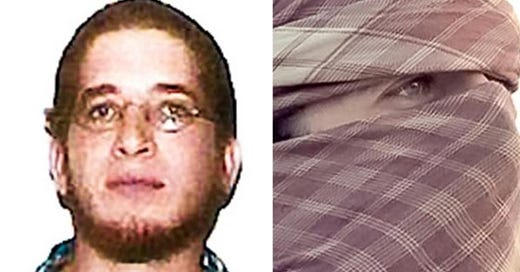“Man is not what he thinks he is, he is what he hides.”
― André Malraux, French novelist and art theorist
As I was tracking down the families of Americans who were allegedly fighting for designated terrorist groups in Syria almost seven years ago, I came across an intriguing case: a San Diego man who had left the beachside city to fight for Al-Shabaab in East Africa.
His name was Jehad Serwan Mostafa.
My curiosity was piqued as to what compelled a young man with a good education, several decent jobs, and a stable family to take such a leap. I knocked on the door of his parents' house where he lived before he left, but no one answered. The cleric at his local mosque told me passionately that there was no sign of extremism when I visited it. I walked by the El Cajon auto repair shop where he worked and was greeted with glum faces and nervous refusals to even utter his name.
A few casual acquaintances who refused to speak on record seemed surprised by Mostafa's escape into the thickets, describing him as "nice," "quiet," and "polite."
Over time, his name slipped from my memory. Continuing my research on another U.S. terrorist case, I saw an FBI alert on my Twitter feed in late 2019: Jehad Serwan Mostafa, then 38, a former San Diego resident – was named the most wanted American terrorist in the world.
“Mostafa is believed to be the highest-ranking United States citizen fighting overseas for a terrorist organization,” U.S. Attorney Robert Brewer stated. “Al-Shabab’s reign of terror threatens U.S. national security, our international allies, and innocent civilians.”
In an unsealed federal indictment, the U.S. citizen, who had already been on the FBI's Most Wanted Terrorists list for years, was charged with additional crimes related to his alleged involvement with Al-Qaeda affiliate Al-Shabab.
In order to clarify the scenario of the southern California terrorist, I went back to the drawing broad. The profiles of these jihadists are essential because before we can understand why, we first need to know who.
So who is Jehad Serwan Mostafa?
(Jehad Serwan Mostafa, credit FBI)
Having fled the United States in December 2005, Mostafa was indicted for the first time in 2010. An expansion of the previous charges is contained in the superseding indictment. At some point between March 2008 and at least February 2017, he "conspired to provide material support, including himself as personnel, to terrorists."
Under the pseudonyms "Ahmed Gurey," "Ahmed," "Abu Anwar al-Muhajir," and "Abu Abdullah al-Muhajir," Mostafa is a high-ranking figure in Al-Shabab's explosives unit, with critical leadership roles in the media and soldier training wings. According to government officials, he was involved in improving the effectiveness of improvised explosive devices used in attacks against U.S. interests and soldiers' bases in the area.
Sources told me, however, that his entanglement goes much deeper.
“Currently, Jehad is in Somalia, and he is very close to the decision-making circles of Al-Shabab, especially their intelligence wing called ‘AMNIYAT’ and also an explosive brigade which is controlled by the powerful Al-Shabab leader, Mahad Warsame Qaley,” an African intelligence official, who spoke strictly on the condition of anonymity,” told me. “Jehad is protected by Al-Shabab hardliners who are mainly connected to Al Qaeda. He directly advises Al-Shabab’s leadership on issues related to strategies, international relations, smuggling explosive material and importation, media production, and its audience targeting.”
Mostafa is said to have three wives and sixteen children. His family is protected by Al-Shabab's General Security, which is "in charge of overseas counter-intelligence and the presence of foreign fighters" within the organization.
“The Middle Jubba region, which is under full control of Al-Shabab, is where intelligence agencies believe is his hideout,” my well-placed source continued. “He is one of the most trusted foreign fighters within Al-Shabab and gets more protection (than others) from the group.”
Another security source in the country confirmed to me that one of Mostafa's wives married him soon after her husband, his comrade, was killed in action. Around two years ago, Mostafa narrowly escaped being captured in a ground operation.
However, his alleged trek into terrorism is a far cry from the baby-faced Southern California boy many viewed as sweet and subdued.
Mostafa was born in Waukesha, Wisconsin, and raised in the Serra Mesa area of San Diego, Calif. He attended Mesa Community College and graduated from the University of California, San Diego with a degree in economics in 2005. Months later, he is alleged to have slipped into the murky world of jihad at the age of 23.
In 2005, Mostafa made his first stop in Yemen. During his stay in the Middle Eastern country, he was said to have struck up a friendship with several Muslims from Western nations. Mostafa traveled through several African countries before arriving in Somalia at Al-Shabab's invitation, when the outfit was making inroads into the embattled country.
After Mostafa disappeared into the group's void, the leadership began warning other foreign fighters not to come, since sweeping arrests had already begun against those aspiring to overthrow the government.
However, Mostafa's path to radicalization caught many by surprise, including those with whom he prayed. He attended the local Islamic Center of San Diego in Kearny Mesa, and its director, Imam Taha Hassane, told me in 2016 that they had no suspicion that Mostafa had become extreme in his views.
“Jehad was often hanging around with the other young people. He used to play a lot of basketball outside,” Hassane recalled. “I was shocked to see his picture on the news connected to terrorism.”
While researching for this profile, a mutual friend of ours told me that Mostafa's father, Halim Mostafa Gabori, died in 2018 from a heart issue.
Halim was a co-founder of the Association for Youth and Community Advancement (AYCA) and was eulogized by the organization as a "people's person" with a "passion for life" and an "important contributor" to the greater San Diego community.
In 1998, Halim founded Aveen, Inc. and, under that canopy, managed the film production company Scimitar Productions. The film, titled "Mozlym," was produced by him and his company in 2008, and aimed to demonstrate that "the true meaning of Islam is lost amid stereotypes about non-Muslims in America," and centered on a young African American who fights his way out of a ghetto and into college, "deciding to make his thesis film about Muslims and violence."
The film went on to win some international awards. Halim also had an uncredited role as an “Iraqi Civilian Man” in the 1999 George Clooney, Mark Wahlberg and Ice Cube-starring war film “Three Kings.”
Furthermore, Halim was the owner and operator of Scimitar Security, which offers a range of security services, including unmanned and armed patrols on residential properties, where Jehad worked before joining the terrorist outfit abroad. Based on a search of Mostafa's professional licenses, he was registered as a guard with the California Bureau of Security and Investigative Services in 2000, valid until August 2006. Additionally, he worked at the Winston Auto Center on El Cajon Boulevard in San Diego.
His mother Sumaiyah Mostafa, according to AYCA, is a retired schoolteacher who has worked and taught in various states and countries.
Family members, including one older brother, a 41-year-old software engineer in Southern California, did not respond to requests for comment. However, a family friend explained that Halim was deeply disappointed and upset over his son’s departure to Africa. His name gradually fell out of the conversation.
Al Shabab, which means "youth" in Arabic, remains one of the world's most deadly terrorist groups, racking up a staggering number of victims in recent years. In the late '90s, it was an insurgent group built around a hardline interpretation of Islam; in 2012, it aligned itself with Al-Qaeda.
Radicalization took place in the group after Ethiopia, which is majority Christian, invaded neighboring Somalia in late 2006, usurping the government from Mogadishu at the request of the transitional government. With the occupation continuing for years, Al-Shabaab – which retreated to the south as a guerilla group – gained momentum.
It is unclear how many people are involved with Al-Shabab, but estimates have ranged from four to ten thousand.
The government of Somalia blamed the group for killing more than 500 people in a massive truck bombing in Mogadishu in October 2017. In 2015, the terror group was responsible for a massacre at Kenya's Garissa University, which killed 148 people. The group's operatives attacked Nairobi's Westgate shopping mall in 2013, killing 67 people. Kenya's foreign minister claimed that some of the militants involved in the mall massacre were Americans, but it is unclear if Mostafa was one of them.
Between 2009 and 2011, Al-Shabab dominated central and southern Somalia. While the group was expelled from the capital in 2011, it has transitioned to a more covert form of guerilla warfare.
Concern that Al-Shabab was reestablishing itself prompted a renewed U.S. focus on the group in the latter years of the Obama administration, and that continued under Trump.
President Trump approved a Pentagon plan to ramp up operations and drone strikes against the insurgency faction during his first months in office.
The Biden administration additionally launched multiple air attacks against the group in Somalia.
More than four thousand people have been killed by Al-Shabab across Africa since 2008, the year it was first designated a foreign terrorist organization (FTO). Thousands more have been seriously injured.
“Al-Shabab is as brutal as they come. The group divides the areas under its control into geographical units it dubs ‘Islamic States’ and administers them according to its understanding of Islamic law,” noted researchers for the Middle East Media Research Institute’s (MEMRI) Jihad and Threat Monitor. “It regularly calls for attacks on American and Western targets worldwide, but so far has not directly carried out any such attacks.”
In addition to Al-Shabab's dizzying array of attacks, the Counter Extremism Project (CEP) says it is also responsible for stonings, amputations, and beheadings, which are often used as "regular punishment for criminals and apostates." The United Nations also claims the group uses children for combat and reconnaissance.
The Department of State's Rewards for Justice Program is offering a $5 million reward for information leading to the arrest and conviction of Jehad Serwan Mostafa. Mostafa remains at large despite the lucrative financial offer that has been on the table since 2013. He is known to speak English, Arabic and Somali.
According to the FBI, his last unclassified proof of life occurred in October 2011, when he appeared at a press conference with top Al-Shabab officials and "pretended to be an Al-Qaeda emissary." The event was captured on camera, during which he praised Osama bin Laden.
Mostafa is described as 6'1" and 170 pounds; blue-eyed, with a light complexion, left-handed, and with a distinctive scar on his right hand. Mostafa faces charges of providing material support to terrorists, providing material support to a foreign terrorist organization, and providing material support to an international terrorist organization.
“His track record amounts for a rap sheet of some big misdemeanors, including serving as Al-Qaeda leader Ayman al-Zawahiri’s point man,” noted Raphael Gluck, founder of the terrorist monitoring site Jihadoscope. “Essentially, he remains hidden. Unless one is a spiritual leader or figurehead, he won’t be releasing videos, and videos won’t focus on him. But someone like Jehad is worth a lot more than a propaganda video.”
So what are some interesting observations regarding the life and times of Jehad Mostafa?
Over the past decade, during which I have spent considerable time interviewing and researching various terrorists and rebel fighters across every region of the globe, I hear almost always the same characteristics when it comes to a fighter raised in the West, who fled to the belly of the beast or launched a terrorist attack on home soil.
It was a surprise to those who knew them that they were involved in terrorism.
In most cases, the perpetrator was quiet, even shy, had a job and usually a family. Although religious, they were not very religious. With the advent of social media, the recruitment process has been accelerated. Jehad Mostafa's recruitment in 2005 predated the in-your-face digital era of today, but chat groups and message boards were still around and less regulated than they are today.
Among western fighters, friendship is the most common characteristic: most had very few or no close companions, and they appeared to seek out a sense of inclusion rather than greater purpose.
Despite the absence of a tried-and-true blueprint of signs to look for in regard to radicalization, I have yet to meet a foreign fighter who seemed to have a solid support system beyond their families or religious affiliations.
In my view, the primary tenant of friendship, or lack thereof, as well as the self-explanatory lone wolf label are key elements of these profiles. Be aware of the need the primal instinct to belong - no matter the circumstances, for better or for worse.















Share this post